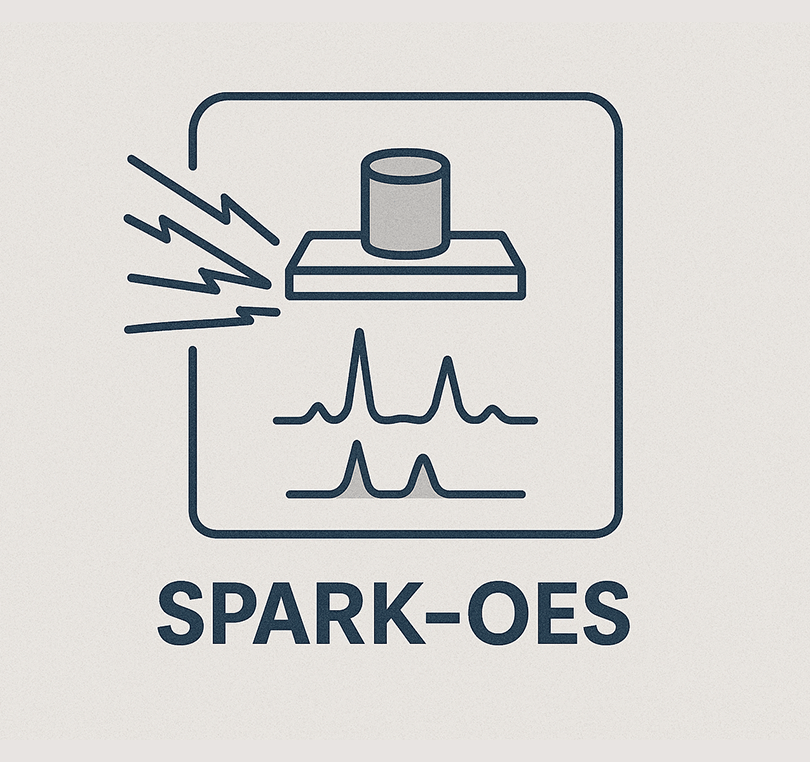Comparison of Two Quantometry Techniques for Metal Analysis

Spark-OES vs ICP-OES: A Complete Comparison for Metal Analysis
1. Why is Quantometry Important?
In industries like steel, aluminum, foundry, and ferroalloys, accurate, fast, and cost-effective chemical analysis is essential. The two most widely used methods are:
| Technique | Sample Form | Response Time | Key Measurable Elements | Typical Detection Limit |
|---|---|---|---|---|
| Spark-OES | Solid (polished metal sample) | 2–5 seconds | C, S, P, B, N and all alloying elements | Down to ppm for most elements |
| ICP-OES (ICP-AES) | Solution (after acid digestion) | 2–5 minutes + prep time | Over 70 elements (except C, O, N, H) | Down to ppb for many elements |
2. How Each Method Works (In Brief)
-
Spark-OES: A controlled spark excites the surface of the solid metal sample into a plasma state. The emitted light is captured by a vacuum optics system, covering a wide spectral range (130–800 nm). Sample prep involves just light grinding.
-
ICP-OES: The sample is dissolved in acid, nebulized into an 8000 K plasma, and the emission lines are measured. Sample prep involves digestion, dilution, and chemical waste disposal.
3. Pros and Cons at a Glance
Spark-OES (Spark Optical Emission Spectrometry)
✅ Ultra-fast (seconds); ideal for production and foundry lines
✅ Measures light elements like C, S, N, B – which XRF and ICP cannot
✅ Low operational cost (no acid or reagents)
❌ Limited to solid, conductive, polished samples
❌ Less sensitive than ICP-OES for trace elements below ppm
ICP-OES
✅ Higher sensitivity for trace elements (ppb level)
✅ Can analyze various matrices (solutions, ash, salts…)
❌ Time-consuming prep with corrosive acids
❌ Cannot measure C, O, N, H
❌ Higher capital and maintenance costs (argon, torch, consumables)
4. Choosing the Right Method
| Your Priority | Recommended Technique |
|---|---|
| Real-time quality control in casting or steel lines | Spark-OES |
| Trace analysis for R&D or regulatory labs | ICP-OES |
| Simultaneous analysis of C, S with other alloying elements | Spark-OES |
| Need to analyze various sample types (liquids, ash, soil) | ICP-OES |
Key Tip: Many facilities benefit from using both – Spark-OES for rapid production QC, and ICP-OES for advanced lab analysis.
5. Conclusion
If speed, ease of use, and measuring light elements like C and S are critical for you, Spark-OES is the natural choice. But for ultra-trace detection in complex matrices, ICP-OES leads the way.
Introducing Unique’S OES – Smart Quantometry for Modern Metal Industries
Unique’S OES, developed by Control System Novin, is engineered for real-world industrial needs:
-
Wavelength range: 140–870 nm with high-resolution CMOS detectors
-
Digital Spark Source (100–800 Hz / 80 A) for stability and repeatability
-
Vacuum optics (6–10 Pa) and adaptable sample holder for all sizes
-
Bilingual software (FA/EN), one-sample recalibration, Excel/PDF export
-
Full elemental coverage for Fe, Al, Cu bases and ferroalloys
For a free consultation or sample testing, contact our expert team today.




